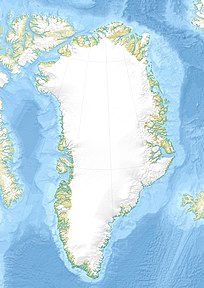Upernavik Kujalleq
| Upernavik Kujalleq (South Upernavik) | ||
|---|---|---|
|
Søndre Upernavik (South Upernavik) Upernavik Kujatdleĸ |
||
| Upernavik Kujalleq heliport with the church in the background (2007) | ||
| Commune | Avannaata Communia | |
| District | Upernavik | |
| Geographical location | 72 ° 9 ′ 0 ″ N , 55 ° 32 ′ 0 ″ W | |
|
|
||
| Residents | 201 (January 1, 2020) |
|
| founding | 1855 | |
| Time zone | UTC-3 | |
Upernavik Kujalleq [ uˈpɜnːavik kuˈjaɬːɛq ] (according to the old spelling Upernavik Kujatdleĸ ) is a Greenlandic settlement in the district of Upernavik in the Avannaata Kommunia .
location
Upernavik Kujalleq is located 73 kilometers south of the district capital Upernavik on a flat headland on the large island of Qeqertaq . The next inhabited place is Kangersuatsiaq, 25 km to the north . Upernavik is the southernmost village in the district.
history
The place was founded as Udsted in 1855. Upernavik Kujalleq was not assigned to the colony, but to the facility in Kangersuatsiaq.
In 1911 Upernavik Kujalleq became its own municipality, which still included the residential areas Ikerasak and Uluaa . The municipality was part of the 11th district council of North Greenland.
In 1918 there were 128 Greenlanders and two Danes in Upernavik Kujalleq. Among them were 25 hunters, six fishermen, the Danish Udsteds administrator, a catechist and a midwife. There were 17 houses and one apartment for the Udsteds administrator, which was very dilapidated and built as a combination of brick, wood and peat walls. It had two rooms and a kitchen and a small outbuilding. There was also a wooden shop from 1912 and a bacon house with a cooperage. The school was the former school chapel, but in 1916 the place received a church. This was a half-timbered building with roof shingles. It measured 150 m² and was painted red with white window frames and decorations on the tower, on which there was also a clock. It had a ceiling height of five meters with a vault supported by ten wooden pillars. Inside it was a church choir, a sermon chair, an ornate wooden baptismal font and sixteen chairs. There was also a large stove and two five-armed brass chandeliers. This church, which was extremely remarkable for the time, was actually supposed to be built in Nanortalik .
Around 1920 Upernavik Kujalleq received a new Udsteds administrator's apartment. In 1928 another school was built. In 1930 Upernavik Kujalleq already had 164 inhabitants. In 1934 and 1937 a packing house was built. The population fell sharply again in the middle of the century: in 1940 there were 147 people living in the village and in 1950 only 106. Then it rose again to 127 inhabitants in 1960 and 136 in 1970.
In 1950 Upernavik Kujalleq became part of the new Upernavik municipality . During the administrative reform in 2009, the place was incorporated into the Qaasuitsup Kommunia . Upernavik Kujalleq has been part of Avannaata Kommunia since 2018 .
economy
Upernavik Kujalleq lives mainly from seal and whale hunting . In the past, more cod and striped sea wolf were caught. The falling population of Greenland halibut has recently led to the closure of the local fish factory. However, the fish trade is still going on.
Infrastructure and supply
The settlement's two-meter-deep harbor is located roughly in the center of the village and is navigable from May to December. Small fishing boats moor here on a three meter long pontoon jetty. In winter and spring, transport is carried out by the Upernavik Kujalleq heliport . In the immediate vicinity, you can get around using dog sleds or snowmobiles .
The electricity, heat and water are supplied by Nukissiorfiit . Fresh water is obtained from the sea by an osmosis desalination system and collected in tanks. Power is supplied by a power station at the cemetery. The wastewater is discharged into the sea. TELE Greenland secures the telecommunication connection of the population.
Development
The Mathiarsip Atuarfia teaches about 40 students to ninth grade. The students then have to move to Upernavik . The village also has two apartments for the elderly, a kindergarten, a citizens' office, a library, the church, a youth center and an assembly building.
Seven buildings in Upernavik Kujalleq are classified as worthy of preservation and are in urgent need of renovation.
Sons and daughters
- Rasmus Villumsen (1907–1930), member of the expedition
Population development
The population of Upernavik Kujalleq has risen sharply since 1980, but has stagnated since then, apart from a small slump around the turn of the millennium.

panorama
Web links
Individual evidence
- ↑ Map with all official place names confirmed by Oqaasileriffik , provided by Asiaq
- ↑ a b c d Upernavik Kujalleq at qaasuitsup-kp.cowi.webhouse.dk
- ↑ Hans Jensen Bryder : Beskrivelse af Distrikterne i Nordgronland: Upernivik Island district. De enkelte Bopladser i Upernivik district. Udstedet Søndre Upernivik . In: Georg Carl Amdrup , Louis Bobé , Adolf Severin Jensen , Hans Peder Steensby (eds.): Grønland i tohundredeaaret for Hans Egedes landing (= Meddelelser om Grønland . Volume 60-61 ). tape 1 . C. A. Reitzel Boghandel, Copenhagen 1921, p. 486 ff . ( Digitized in the Internet Archive ).
- ↑ Jens Christian Madsen: Udsteder og bopladser i Grønland 1901-2000 . Atuagkat, 2009, ISBN 978-87-90133-76-4 , pp. 188 f .
- ^ Upernavik Kujalleq in Den Store Danske
- ↑ Population Upernavik Kujalleq 1977-2020 at bank.stat.gl



